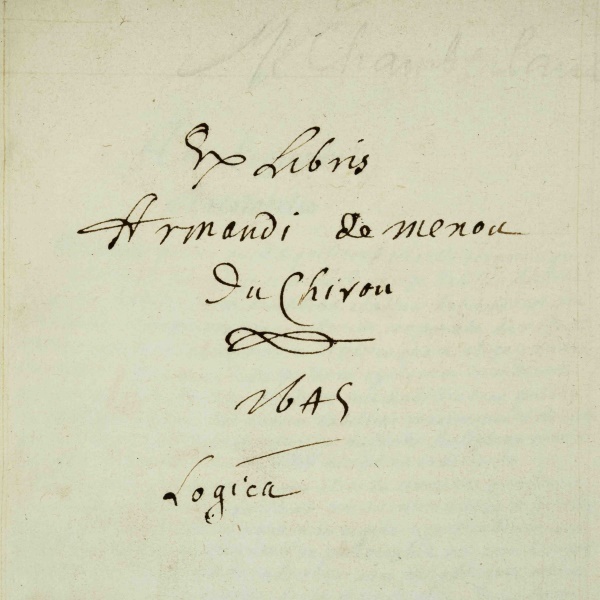Commentary on Aristotle's 'Logic'
The book displayed here belonged to Armand-François de Menou du Chiron. Though a little-known French nobleman, Armand has been studied by Jacques Jarriot as a prototypical example of the French provincial nobility as Armand and his family were much involved in the events of their time. Armand’s father, François, was a captain in the king’s army, commanding a cavalry unit at the siege of La Rochelle (Jarriot 81).
Born in 1629, Armand was named for his father and his father’s cousin, Cardinal Richelieu (81), the powerful cardinal of the French throne during the reign of Louis XIII. Following in his father’s footsteps, Armand became an ensign at age 15, eventually serving in the Queen Mother’s Regiment and in the French Guards (82).
Armand’s military career ended when he was wounded in the knee at age 23. At this point, he returned to his family lands, where he lived the typical life of a mid-level nobleman, becoming Lord of Charnizay after his father and spending his time amassing wealth, gaining royal favors, and disposing of his eight surviving children (82). In 1697, he was made a marquis by Louis XIV (81). He died in 1703 at the age of 74. Armand has been studied by Jacques Jarriot as a prototypical example of the French provincial nobility (81).
According to an inscription in the front, this commentary on Aristotle’s Logic, simply called Ad Logicam Aristotelis (On Aristotle’s Logic), entered Armand’s library in 1644. Not surprisingly, the text is in Latin. Though Aristotle himself wrote in Greek, and Greek was becoming more widely known in the wake of the Renaissance, university students were unlikely to be fluent in it. At the same time, though vernacular languages had attained literary status, Latin was still the language of scholarship—every schoolboy new it, and, while losing ground, it was still a lingua franca of the elite.
This work is not a “commentary” in the usual sense, as it does not follow a particular text or texts but rather comments on aspects of Aristotle’s Logic in general. The text is arranged in 18 disputations, or questions subjected to argument, each with a varying number of articles contained within them. Topics vary widely, including the nature of logic, the object of logic, against the nominalists and the Platonics, the nature of substance (understood in light of Aristotle’s Categories), and discourse and syllogism. Within these broad topics, the author frequently seems to approach logic as a rhetorical tool and asserts that rhetoric and poetry are part of logic. These characteristics suggest that this is school text, very possible lecture notes. This possibility seems even more likely when the book itself is examined. The handwriting, though it starts quite neatly, becomes cramped and sloppy; there are a fair number of corrections to the text, as well as ink blotches. These features suggest a non-professional copyist. In this period, students sometimes copied their own books (and a textbook could simply be a professor’s lectures); they also made clean copies of their lecture notes from classes. Thus, it might be that the young Armand himself copied this text. In either case, its being a school text would be consistent with Armand’s age at the time it entered his library, that is, 15. Or, the date might represent the date of the lectures, which were copied out later.
In keeping with the “textbook” genre, the work opens with a discussion of important terms and their proper use. For example, the author explains that words such as “art,” “ability,” “virtue,” and “knowledge” have ordinary meanings, but also technical philosophical ones, and when they are used in the latter sense, one should say “art, properly speaking” and so on. As he moves into the first disputation, the author becomes much more precise. As he discusses the meaning of words such as “logic” and “dialectic,” he explains how different Greek commentators have used them, how they are translated into Latin, and where within Aristotle’s works the words are used or defined (for example, in the Categories, in the Metaphysics, etc.).
The end of the work, however, is a bit different from what we might expect. The final article asks, “What is faith?” The author then discusses the intersection of faith and reason, seeing them as compatible. His general approach is Thomistic, that is, in line with the work of St. Thomas Aquinas. At the end, he argues that people in heaven do not need faith because they see the face of God, unlike those of us on earth. This, perhaps, becomes especially intriguing as the final point of discussion when one knows that, according to medieval legend, Aquinas himself said that his great work, the Summa, was pointless once he had had the beatific vision.
In this instance, the statement might be less indicative of the author of the commentary’s great piety than of the religiopolitical climate of the time. Europe was not quite done with the age of religious warfare; wars between Catholics and Protestants had ravaged Germany for nearly thirty years; Armand’s own father had fought with the Catholic king’s troops against the Huguenot, Protestant rebels in the Siege of La Rochelle less than two decades earlier; and in that very year, the armies of Oliver Cromwell and the Puritan Roundheads were engaging the king’s cavaliers in England. Thus, like Armand, this commentary is, in many ways, emblematic of its time.
—Bobbi Sutherland, PhD, Professor, History
Source
Jarriot, Jacques. “Une famille de ‘bon ménagers’: la branche nivernaise de Menou de Charnizay aux XVIIe et XVIIIe siècles.” Revue d’histoire moderne et contemporaine 23 n.1 (1976): 80- 101.

